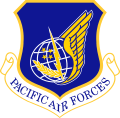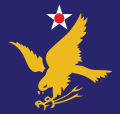Combat in the European Theater
On arrival in England, half of the 401st Group's aircrews were immediately reassigned to the 351st Bombardment Group. [6] The rest of the squadron became part of Eighth Air Force at RAF Deenethorpe. The 615th became part of the 92d Combat Bombardment Wing of the 1st Bombardment Division. The group's tail code was Triangle-S.
On 26 November the 615th flew its first combat mission against Bremen, Germany. [7] The 401st Group did not suffer the combat loss of an airplane until its ninth mission on 30 December. [8] The squadron operated chiefly against strategic targets, bombing industries, submarine facilities, shipyards, missile sites, marshalling yards, and airfields. [3] On 11 January 1944 the squadron was in the lead group of the 1st Bombardment Division in an attack against aircraft manufacturing facilities at Oschersleben, Germany. Although the bombers were able to attack, poor weather conditions prevented the division from receiving effective fighter cover. For over three hours the bomber formation suffered more than 400 attacks by Luftwaffe fighters, including air-to-air rocket attacks. Despite these attacks the unit continued its attack and struck a telling blow against German aircraft production for which the squadron was awarded a Distinguished Unit Citation (DUC). [3] [9]
A little over a month later, on 20 February, the squadron earned its second DUC for an attack on the Erla Maschinenwerke aircraft manufacturing facilities in Leipzig, Germany. Despite fighter attacks and battle damage to the group's planes, 100% of the unit's bombs fell within 1000 feet of the aiming point. [3] [10] Beginning in October 1944, the unit concentrated its attacks on Axis oil reserves. [3]
In addition to strategic missions, squadron operations included attacks on transportation, airfields, and fortifications prior to Operation Overlord, the Normandy invasion. On D-Day the 615th attacked Normandy beachhead areas dropping bombs five minutes before troops landed. [11] The following month it provided close air support for Operation Cobra, the breakthrough at Saint-Lô, it also supported the siege of Brest in August and Operation Market Garden in September. During the Battle of the Bulge in December 1944 and January 1945, the unit attacked transportation and communications in the battle area. It supported airborne forces involved in Operation Varsity, the airborne assault across the Rhine in March 1945. [3]
The squadron flew its last combat mission on 20 April 1945 against Brandenberg. [12] It had flown 254 combat missions from Deenethorpe airfield. [13] After V-E Day, the squadron flew missions to Linz, Austria to evacuate British and French prisoners of war. It also flew "Trolley" sightseeing missions at low level, flying ground support personnel over the Ruhr and Frankfurt am Main to see the damage that had been done as a result of their efforts. [14]
The unit was alerted for redeployment to the Pacific Theater and the last plane departed Deenethorpe in early June. The ground echelon sailed on the RMS Queen Elizabeth on the fifth. [15] Upon arrival in the US, personnel were granted thirty days leave, reassembling at Sioux Falls Army Air Field, South Dakota, but plans had changed and personnel were either transferred to Boeing B-29 Superfortress units or processed for discharge and the group was inactivated. [16]







